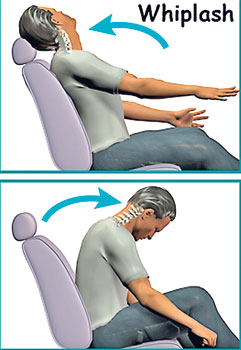A pain in the neck, literally that is what it is, sometimes also with a headache.
It can come about if you have been in a car or a van, especially in the rear seat, when there is a bang from behind and another vehicle has hit the one you are travelling in. The accident may be a minor one but you are jerked forward and then backward.
When the neck bends forward forcibly and then backward or the other way round, a person may suffer a whiplash injury, explains Consultant Orthopaedic Surgeon Dr. Upali Banagala of the National Hospital in Colombo.
 |
| Pic courtesy eorthopod.com |
The injury, involving the muscles, discs, nerves and tendons of the neck can also be caused sometimes through contact sports, MediScene learns.
"Usually, the neck area of the spine called the cervical spine is 'c' shaped," says Dr. Banagala, adding that due to this type of accident it could take the shape of an 's', resulting in a whiplash injury.
If the upper part of the neck bends forward due to the ligaments behind the neck becoming stretched, the person will have an ache at the back of the head and also the neck. If the lower part of the neck bends backwards, as the facet joint there gets pinched, there will be a pain in the lower part of the neck and also the upper shoulder area, he says.
Whiplash is when the soft tissues of the neck are injured by a sudden jerking or "whipping" of the head. This type of motion strains the muscles and ligaments of the neck beyond their normal range of motion.
Although neck pain is the predominant and headache the second-most common symptom of whiplash injury, there could also be neck stiffness, shoulder pain, low back pain, dizziness, pain in the arm and/or hand, numbness in the arm and/or hand, ringing in the ears, blurred vision, concentration or memory problems, irritability, sleeplessness or tiredness.
The treatment would include ice applications for the first 24 hours, a cervical collar, only gentle active movement after 24 hours, non-steroidal anti-inflammatory medications, muscle-relaxing medications and physiotherapy, adds Dr. Banagala.
It is self-limiting and the symptoms will settle in 3-6 months. Only very rarely will the symptoms persist for a long time, says this Orthopaedic Surgeon adding that after the acute stage too the patient should take such precautions as looking after his neck by sleeping without a pillow and only gently moving the neck.
|

